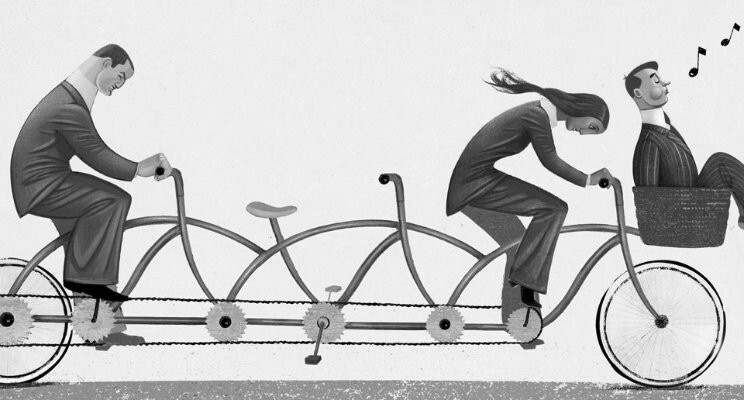Introduction
In our interconnected world, collective action plays a crucial role in addressing common challenges and achieving shared goals. However, the Free Ride Problem presents a significant obstacle to effective cooperation. This mental model describes the tendency of individuals or groups to exploit the contributions of others while minimizing their own involvement or investment. Understanding this concept is essential for making informed decisions and promoting collaboration. In this blog post, we will explore the Free Ride Problem, its relevance in decision-making processes, its prevalence in our daily lives, and strategies to mitigate its negative impact.
Defining the Free Ride Problem and its Relevance
The Free Ride Problem refers to the phenomenon where individuals or groups benefit from a collective effort without making a proportional contribution. It is rooted in the rational self-interest of individuals seeking to maximize their own benefits while minimizing their costs or efforts. This model is highly relevant in decision-making processes, particularly when it involves cooperation, shared resources, public goods, or group efforts. Understanding the dynamics of the Free Ride Problem can help us identify situations where individuals may exploit the contributions of others, leading to suboptimal outcomes and undermining collective action.
Anchoring the Free Ride Problem in Human Psychology
The Free Ride Problem is deeply anchored in human psychology. It taps into cognitive biases such as social loafing, where individuals exert less effort in a group setting due to a diffusion of responsibility. Additionally, the availability heuristic can lead individuals to rely on the contributions of others when the benefits are readily apparent, assuming that others will carry the burden. This cognitive bias can overshadow the importance of individual participation and contribution.
Prevalence of the Free Ride Problem in Various Contexts
- Personal Life Decisions: Consider a scenario where a group of friends plans a beach cleanup event. If some individuals believe that others will carry the majority of the workload, they may contribute less or even skip the event altogether. This behavior results in an unequal distribution of effort, with a few individuals bearing the burden while others benefit without participating fully.
- Business Scenarios: In a business context, the Free Ride Problem can manifest in team projects. If team members perceive that their contributions will not significantly impact the final outcome, they may exert less effort or rely on others to carry the load. This leads to imbalanced work distribution and compromises the overall quality of the project.
- Public Policy-Making: The Free Ride Problem also affects public policy-making. For example, if a government proposes a tax increase to fund a public good, some individuals may attempt to avoid paying their fair share, expecting others to cover the costs. This behavior undermines the provision of essential services and creates an unfair burden on those who do contribute.
Mental Biases and Psychological Underpinnings
Several mental biases contribute to the Free Ride Problem. The free rider bias stems from the belief that one’s individual contribution will not significantly impact the collective outcome. The bystander effect, where individuals assume someone else will take action, can also contribute to the problem. Furthermore, the illusion of transparency, where individuals overestimate how apparent their contribution is to others, can lead to reduced effort.
Strategies to Identify and Mitigate the Free Ride Problem
- Establish Clear Expectations and Communication: Clearly communicate the expectations for individual contributions in a collective effort. Ensure that everyone understands their role, responsibilities, and the importance of their participation. This clarity minimizes ambiguity and fosters a sense of accountability.
- Encourage Active Participation and Collaboration: Promote a culture of active engagement and collaboration. Encourage individuals to take ownership of their contributions and emphasize the value of collective effort. Create opportunities for open dialogue, brainstorming, and sharing ideas, fostering a sense of shared responsibility and commitment.
- Implement Monitoring and Feedback Mechanisms: Establish monitoring and feedback mechanisms to track individual contributions and provide regular updates on progress. This helps prevent free riding by making individual efforts more visible and provides an opportunity to address any imbalances or issues early on.
- Incentivize Cooperation: Design incentives that align individual interests with collective goals. Reward active participation and recognize the contributions of individuals to foster a sense of fairness and motivation. Incentives can be both tangible (such as rewards or recognition) and intangible (such as a sense of purpose or belonging).
Conclusion
The Free Ride Problem presents a significant challenge in decision-making processes that involve collective action. By understanding the psychological underpinnings and biases that contribute to this problem, we can implement strategies to mitigate its negative impact. Clear communication, active participation, monitoring mechanisms, and appropriate incentives can foster a sense of collective responsibility and promote more effective cooperation. By addressing the Free Ride Problem, we can harness the power of collaboration and achieve optimal outcomes for the collective good.
